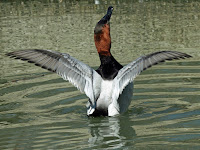CANVASBACK
CANVASBACK (Aythia valisineria) – (See images below)
DESCRIPTION: The Canvasback drake has a black head cap and reddish brown face and neck. Breast and rump are black. Back and under parts are white, wings are mostly light grey. Eyes are red, bill, legs and feet are black. Non-breeding male has light grey back and wings with a reddish brown head and neck (cap is darker). Breast and rump are brown. Female is light brown with a darker patch at the neck base. Eyes are brown, bill is dark grey. Bird length is around 49 cm (19 inches).
VOICE: https://www.xeno-canto.org/species/Aythya-valisineria
NAME: ‘Canvasback’ refers to the duck’s back color. Latin genus name ‘Aythia’ comes from Greek and refers to a ‘kind of waterbird’. Latin species name ‘valisineria’ refers to one of the main foods of this duck, water celery.
HABITAT: Freshwater wetlands (marshes) in the summer; lakes, along the coasts (estuaries, bays) in the winter.
DIET: Aquatic vegetation (especially water celery) for the most part, also fish, insects, molluscs.
NESTING: Nest usually located above water in thick emerging vegetation. Between eight and twelve dark green are laid, incubated by female. Ducklings are able to feed themselves, but are cared for by the mother. Sometimes redheads will lay eggs in a canvasback nest.
DISTRIBUTION: Breeding range covers the Prairie Pothole Region, as well as wetlands in the western half of the North West Territories, Yukon and central Alaska. During migration canvasbacks can be observed in southern Canada and northern USA. Wintering grounds include the remainder of the USA, and Mexico. Some individuals have been reported in Europe, even on Hawaii. (see note below on Bird Vagrancy).
Distribution Map: https://en.wikipedia.org/wiki/Canvasback#/media/File:Aythya_valisineria_map.svg
ON PEI: Does not breed on Prince Edward Island, sightings accidental so far.
CONSERVATION: Numbers in decline, habitat loss on nesting grounds might be a factor.
NOTES: Thanks to its diet of wild celery, this species has a much appreciated taste by hunters.
Vagrancy: In biology this means an animal going way outside its normal range. For birds, this can happen when there are storms and they get blown off course. On other times, the bird simply wanders in a different direction than usual. Here’s an article about vagrancy in birds.
SIMILAR SPECIES: Redhead
REFERENCES: https://en.wikipedia.org/wiki/Canvasback
http://www.hww.ca/en/wildlife/birds/canvasback.html (Hinterland Who’s Who)
https://www.audubon.org/field-guide/bird/canvasback
https://www.ducks.ca/species/canvasback/
https://www.allaboutbirds.org/guide/Canvasback/id
https://nature.mdc.mo.gov/discover-nature/field-guide/canvasback (Missouri Department of Conservation)
http://fieldguide.mt.gov/speciesDetail.aspx?elcode=ABNJB11020 (Montana Field Guide)
https://animaldiversity.org/accounts/Aythya_valisineria/ (University of Michigan)
https://birdatlas.mb.ca/accounts/speciesaccount.jsp?sp=CANV&lang=en (Manitoba Breeding Bird Atlas)
DESCRIPTION: The Canvasback drake has a black head cap and reddish brown face and neck. Breast and rump are black. Back and under parts are white, wings are mostly light grey. Eyes are red, bill, legs and feet are black. Non-breeding male has light grey back and wings with a reddish brown head and neck (cap is darker). Breast and rump are brown. Female is light brown with a darker patch at the neck base. Eyes are brown, bill is dark grey. Bird length is around 49 cm (19 inches).
VOICE: https://www.xeno-canto.org/species/Aythya-valisineria
NAME: ‘Canvasback’ refers to the duck’s back color. Latin genus name ‘Aythia’ comes from Greek and refers to a ‘kind of waterbird’. Latin species name ‘valisineria’ refers to one of the main foods of this duck, water celery.
HABITAT: Freshwater wetlands (marshes) in the summer; lakes, along the coasts (estuaries, bays) in the winter.
DIET: Aquatic vegetation (especially water celery) for the most part, also fish, insects, molluscs.
NESTING: Nest usually located above water in thick emerging vegetation. Between eight and twelve dark green are laid, incubated by female. Ducklings are able to feed themselves, but are cared for by the mother. Sometimes redheads will lay eggs in a canvasback nest.
DISTRIBUTION: Breeding range covers the Prairie Pothole Region, as well as wetlands in the western half of the North West Territories, Yukon and central Alaska. During migration canvasbacks can be observed in southern Canada and northern USA. Wintering grounds include the remainder of the USA, and Mexico. Some individuals have been reported in Europe, even on Hawaii. (see note below on Bird Vagrancy).
Distribution Map: https://en.wikipedia.org/wiki/Canvasback#/media/File:Aythya_valisineria_map.svg
ON PEI: Does not breed on Prince Edward Island, sightings accidental so far.
CONSERVATION: Numbers in decline, habitat loss on nesting grounds might be a factor.
NOTES: Thanks to its diet of wild celery, this species has a much appreciated taste by hunters.
Vagrancy: In biology this means an animal going way outside its normal range. For birds, this can happen when there are storms and they get blown off course. On other times, the bird simply wanders in a different direction than usual. Here’s an article about vagrancy in birds.
SIMILAR SPECIES: Redhead
REFERENCES: https://en.wikipedia.org/wiki/Canvasback
http://www.hww.ca/en/wildlife/birds/canvasback.html (Hinterland Who’s Who)
https://www.audubon.org/field-guide/bird/canvasback
https://www.ducks.ca/species/canvasback/
https://www.allaboutbirds.org/guide/Canvasback/id
https://nature.mdc.mo.gov/discover-nature/field-guide/canvasback (Missouri Department of Conservation)
http://fieldguide.mt.gov/speciesDetail.aspx?elcode=ABNJB11020 (Montana Field Guide)
https://animaldiversity.org/accounts/Aythya_valisineria/ (University of Michigan)
https://birdatlas.mb.ca/accounts/speciesaccount.jsp?sp=CANV&lang=en (Manitoba Breeding Bird Atlas)
 |
| Canvasback drake, Las Gallinas Wildlife Ponds, CA - by Frank Schulenburg , Jan. 2014 |
 |
| Canvasback hen and her ducklings Anchorage Coastal Wildlife Refuge, AK Donna Dewhurst, USFWS |
 |
| Canvasback drake, Sylvan Heights Waterfowl Park, NC, by Dick Daniels |